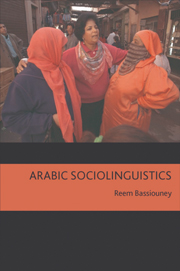Book contents
- Frontmatter
- Contents
- Acknowledgements
- List of charts, maps and tables
- List of abbreviations
- Conventions used in this book
- Introduction
- 1 Diglossia and dialect groups in the Arab world
- 2 Code-switching
- 3 Language variation and change
- 4 Arabic and gender
- 5 Language policy and politics
- General conclusion
- Bibliography
- Index
4 - Arabic and gender
Published online by Cambridge University Press: 05 August 2013
- Frontmatter
- Contents
- Acknowledgements
- List of charts, maps and tables
- List of abbreviations
- Conventions used in this book
- Introduction
- 1 Diglossia and dialect groups in the Arab world
- 2 Code-switching
- 3 Language variation and change
- 4 Arabic and gender
- 5 Language policy and politics
- General conclusion
- Bibliography
- Index
Summary
God created Eve from Adam's bent lower rib. That is why women are always twisted. They never talk straight.
An Egyptian Bedouin recounting the story of Adam and Eve, quoted by Abu-Lughod (1987: 124)INTRODUCTION
The idea that women never talk straight is an assumption found not only among the Bedouins in Egypt, but also more universally. Holmes (1998: 461) contends that the myth that women talk too much exists in all cultures. Supposedly women do not know their own minds. They hedge and qualify everything they say. As Holmes puts it, they are supposed to be ‘indirect and devious’ (1998: 461).
However, the presupposition that men and women, because of their sex differences, speak differently should not be taken as a given. The research on gender has moved and developed beyond this presupposition. Holmes and Meyerhoff (2003b: 9) contend that when linguists make generalisations about a community at large, they apply their generalisations to both men and women. Gender is still an essential factor in language variation and change, but, it is a factor that interacts with other independent variables in a community, i.e. it has to be ‘put into context’ (2003b: 9). Sadiqi (2003a: 312) posits that it is in fact only within a particular culture that ‘gender performance acquires meaning.’
This chapter gives an overview of the study of gender in the field of linguistics in relation to Arabic. Gender has been defined by Coates (1993: 4) as ‘the term used to describe socially constructed categories based on sex’.
- Type
- Chapter
- Information
- Arabic Sociolinguistics , pp. 128 - 197Publisher: Edinburgh University PressPrint publication year: 2009



